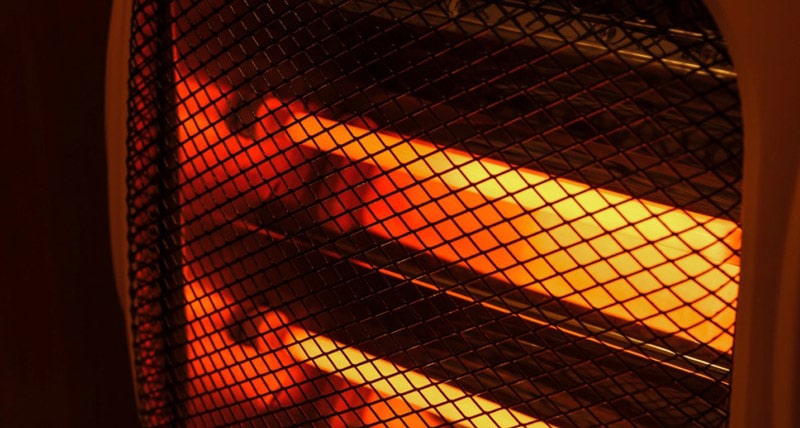Infrared heaters are amazing appliances, but have you ever wondered how they work? Here’s a simple guide to explain it, along with some useful information.
Heaters of all kinds are modern-day comforts that we’ve come to love, but sometimes fail to appreciate. The possibility of having a steady heat source inside our rooms, or out by our gardens, solves a lot of problems.
As technology has advanced, more and more different models of heaters have hit the market, and become popular amongst consumers. And while all types of heaters do their job just fine, some, such as infrared units, have been more appraised than others in recent years.
These offer several advantages over their propane and oil counterparts, yet, surprisingly, there’s still not enough information out there regarding how they work, what their benefits are, or how long you should expect them to last.
If you’re reading this, you’ve been asking these questions yourself, but have likely found no answer to them.
This is why, I’ve prepared the sections below.
In them, you will find everything you might want to know about infrared heaters, including their heating processes, and why they could be the heating solution you need.
Sounds good? Let’s get to work!
First, a Little Trivia
Before delving into the technical aspects of how these heaters work, I’d like to tell you a little about their history, and the practical uses they have in several industries.
Infrared technology was first discovered and harnessed by German-British astronomer Sir William Herschel. During his experiments, he realized that, out of all the color spectrum, red light provided the highest temperatures.
This discovery paved the way for numerous inventions and uses for infrared heating.
Outside households and factories, infrared technology can also be found in hair salons for hair drying, and in some restaurants for cooking.
I bet you had never thought about this before, huh?
Understanding How Infrared Heaters Work
First, let’s talk about how these appliances go about heating your living or working spaces.
These units use the same principle as the Sun to both conduct and radiate heat anywhere they’re pointed at. Have you ever stood outside your home during a cold winter morning, freezing and shivering, only to find sweet relief when the Sun starts peeking in between the clouds?
Well… you have infrared rays to thank for that!
You see, as opposed to propane models, which heat up the surrounding air, infrared units use a much more direct heating approach, which immediately raises the temperature in the area within their scope.

The moment you turn on your infrared heater, millions of infrared waves are radiated from the source, towards the area you’re pointing it at.
Now, a lot of people hear the word “radiation”, and immediately start to panic. But there’s no reason to. Infrared radiation is completely safe and harmless, unless you use your heater irresponsibly.
Having made that clear, let me tell you what happens to these waves after they’ve left your heater.
As soon as they hit something other than air (like you, or furniture, for example), they get absorbed by whatever material they’ve come into contact with. This allows for conduction, which spreads these waves throughout the entirety of the object’s surface.
To make this clearer, let’s put it in a less technical context. Conduction is what allows your food to cook, as the heat from the fire coming from your stove top, is absorbed by the metal in your pot, and distributed both around, and within it.
Benefits and Downsides of Infrared Heaters
Now that you know how the technology behind it works, it’s time to take a look at what it can do for you, and where you need to be careful.
Here are some pros and cons for you to analyze:
The Good
#1 High Heating Efficiency
One of the great things about infrared heaters is that, as opposed to their propane counterparts, they harness all the energy they consume.
If you’re not certain what heating efficiency means, let me explain it to you with one of my favorite examples. Imagine you’re trying to pour water into a cup from a jar. If all the water that leaves the jar ends up filling the cup, you have 100% efficiency.
And every droplet that falls outside the container, decreases it.
This same principle applies to your infrared heater, so you can rest assured that none of the electricity drawn from it will be wasted.
#2 Energy Saving

Okay, so now we’ve established that 100% efficiency means no electricity waste. But how does that translate into saving you money every month?
The answer is simple. The better your infrared heater takes advantage of the energy it consumes, the less of it you’ll need to achieve the desired results.
Some manufacturers even claim their heaters to consume up to 40% less power than other heating solutions.
#3 Direct Heating
This one’s a bit of a double-edged sword.
The advantage of direct heating is that you can sense it almost immediately. Think back to the example of standing out in the cold under the sunlight. The surrounding air will stay cool, but you, and every object under it, will feel much warmer.
Now, since these heaters’ range is a lot smaller than the Sun’s, you’ll benefit much more from this technology in smaller spaces.
#4 No Room Pollution

As opposed to other heating solutions, such as propane-based units, infrared heaters do not release any kind of harmful chemical or particles into the air. This translates into no pollution in your living spaces, and no need for a ventilation solution.
If you like “green” alternatives, you’ll love this technology. That is… unless you also consider the CO2 emissions from the power plant your home gets electricity from. But hey, it’s the little things that matter, no?
#5 Minimal Maintenance Needs
Another great thing about infrared heaters is that they need little to no maintenance. Since there are no moving parts whatsoever inside them, very few things can break or malfunction.
Other heating solutions need you to keep their pilots and gas lines clean, and replace their canisters constantly. Something you’ll never have to worry about when it comes to infrared units.
I don’t know about you, but I love appliances that are plug and play. They make life so much easier!
#6 Long Lifespan
If you’re reading this because you’re planning on spending your hard-earned money on a new heater for your home, you want to get the best bang for your buck, right?
One of the most important things I learned in finance class, is that a purchase’s utility should exceed its period of payment. And with infrared heaters, you won’t have a problem making this a reality.
There are three main types of infrared heaters out there: carbon, quartz and panel, and each one has a different lifespan.
Just to give you an idea of how long these heaters can last, the shortest lifespan of them all, which is about 10,000 hours, belongs to carbon models. This means that you can expect to use your heater six hours a day for 4.5 years before it dies.
Not too shabby, huh?
The Bad
As you can see, infrared heaters are great for a lot of things. However, nothing in this life is perfect, so, sadly, there are also some bad aspects to them.
#1 Quick Heat Dissipation

Going back to our earlier example about the Sun and instant warmth, do you remember what happens when a cloud gets in the way?
That’s right, you immediately start feeling cold again, there is no lasting heating sensation.
Since infrared heaters use the same heating approach as our system’s star, heat dissipates rather quickly after they’ve been turned off. In order to stay warm while using your unit, you’ll have to keep it on at all times. And, as you can imagine, that can severely skyrocket your utility bills.
#2 Lighting Issues
If you’re a YouTuber, you can probably turn this from a nuisance, into a nice feature for background lighting. But in every other case, you might find yourself in an inconvenient situation.
You see, infrared heaters normally glow with a bright red light that can easily and quickly color a room and make it look like one of those old sinking submarine movies. This is obviously much more noticeable when the lights are off, so it might not bother you too much during the day.
However, if you like keeping your heater on overnight, this is certainly something you want to consider. A bright red light is not the most soothing ambience for a good night’s sleep.
#3 Targeted Heating
Remember earlier when I told you this was a double-edged sword? Well, this is what I meant.
While targeted heating will allow your infrared unit to warm you up almost immediately, it will also hinder its ability to heat up the entire room. As opposed to propane heaters, for example, infrared appliances fail to heat up the surrounding air, and focus only on the spot they’re pointed at.
That being said, if you’re only looking to keep yourself warm and don’t mind having cold spots around your living spaces, this won’t be too much of a problem for you.
The Ugly
#4 Potential Hazard if Used Improperly
Since infrared heaters use the same heating principle as the Sun, the adverse reactions your body could have to them after long exposure, could be similar.
Some people have reported feeling dehydrated, and a minuscule group of other individuals, have reported mild skin conditions, such as dryness, and irritation after extended periods of use and exposure to the infrared rays.
Now, before you shun the possibility of buying an infrared unit, I want to assure you that, when used responsibly, these appliances are perfectly safe to use.
I wanted to include this point because no stone shall be left unturned, but, in most cases, you should never experience any kind of health issues derived from the heater.
Conclusion
We’ve grown so accustomed to our modern appliances, that we rarely ever take the time to learn how they work.
Understanding the basic principles of operation behind infrared heaters is essential not only to learn how to use them adequately, but also to prevent any kind of accidents stemming from misuse.
I hope this piece has given you a clearer idea as to how these units go about heating your living spaces, and what are the areas where they truly shine.
Thank you so much for sticking with me all the way to the end. If you found this article helpful, why not become an expert in the subject through our other incredible resources below?
I wish you all the best!







